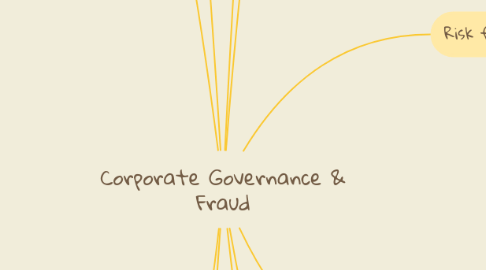
1. Guidelines
1.1. Anything goes!
1.2. No criticism or flaming allowed
1.3. The Wilder The Better
1.4. Quantity is Quality
1.5. Set a Time Limit
2. Types of Fraud
2.1. Financial Statement fraud
2.2. Asset Misappropriation
2.3. Corruption
2.4. Bribery
2.5. Falsification of expenses claim
2.6. Falsifying supplier invoices
2.7. Stock/ raw material theft
2.8. Tax evasion
3. Red flag
3.1. Common personality traits of fraudster
3.1.1. Domineering/controlling
3.1.2. Do not like people reviewing their work
3.1.3. Often work excessive overtime
3.1.4. Rarely take leaves
3.2. Common sources of pressure
3.2.1. Unreasonable performance goal
3.2.2. Spouse lose a job
3.2.3. Need to maintain a certain lifestyle
3.2.4. Drug/alcohol/gambling addiction
3.3. Changes of behavior
3.3.1. Suddenly appears to be buying more material items
3.3.2. Starts to carry unusual amount of cash
3.3.3. Become unreasonably upset when questioned
3.3.4. Start coming early/ coming late at work
4. Roles & Structure of CG
4.1. Chairman
4.1.1. Provide leadership for the board
4.1.2. Lead the board meetings and discussions
4.1.3. Setting the board agenda
4.2. Board of Directors
4.2.1. To review the adequacy and integrity of the management
4.2.2. Set strategies plan for business operation
4.2.3. Oversee the management of company business
4.3. Company Secretary
4.3.1. Advise the board on its roles and responsibilities
4.3.2. Facilitate the orientation of new directors and assist in director training and development
4.3.3. Advise the board on corporate disclosures and compliance with company and securities regulations and listing requirements
4.4. Audit Committee
4.4.1. Definition
4.4.1.1. to assist BOD in discharing their reating to entity which internal conrol , accounting policies , financial reporting and a line of communications between board and the auditors
4.4.2. Objective
4.4.2.1. To ensure quality of executive management and the effectiveness of board of supervision
4.4.2.2. Strengthening accountability of corporate governance
4.4.2.3. Provide greater protection for shareholders and investing as well as depositing public.
4.4.3. Structure
4.4.3.1. at least three members
4.4.3.2. appointed by the Board or the shareholder
4.4.3.3. all members should be independent non-executive directors
4.4.3.4. a member shall not has any relationship with the executive director of the company or related companies or any relationship that would interfere the independent judgement
4.4.3.5. at least one should be a member of an accounting association or body
4.4.4. Roles
4.4.4.1. To recommend statutory auditor to Board
4.4.4.2. Assist directors in discharging their statutory duties and responsibilities
4.4.4.3. Review and provide advice
4.5. Internal auditor
4.5.1. Control assessment by review internal control
4.5.2. Review process by review the documentation of operation
4.5.3. Reporting to board of directors
4.6. External auditor
4.6.1. Provide assurance of financial statement
4.7. Risk management committee
4.7.1. Identify the risk associate and risk assessment
4.7.2. Identify risk mitigation
5. Importance of CG
5.1. To secure shareholder recognition
5.2. To capture stakeholder’s interest
5.3. Clear outlined of board responsibilities
5.4. To control the ethical behavior
5.5. To ensure business transparency
5.6. Tools for risk mitigation
6. Risk of fraud
6.1. 1. Effectiveness of internal control
6.1.1. improper documentation
6.1.2. Physical control of assets
6.1.3. Authorization
6.1.4. Seggregration of duties
6.1.4.1. Example: Accounting Department
6.1.4.2. Example: Purchase Department
6.1.5. Monitor and supervision
6.1.6. Poorly design of control in IT department
6.1.6.1. Unauthorized access to system
6.1.6.2. Override of System control
6.1.6.3. Misuse of computer data
6.2. 2, Nature business of company
6.3. 3. Ethics and values of the company and its employee
6.3.1. Lack of a clear written policy and procedure
6.3.2. not clear organizational structure
6.3.3. and absence of fair employment practice
6.4. 4.Lack of independency of the audit committee
7. Risk factor of fraud
7.1. Pressure
7.1.1. Greed
7.1.2. Lavish lifestyle
7.1.3. financial difficulities
7.2. Opportunity
7.2.1. Cause
7.3. Capability
7.3.1. Position in the company
7.4. Rationalization
7.4.1. reconciling behavior
8. Theories of fraud behavior
8.1. Tips of the iceberg of fraud
8.2. Potato chip theory of fraud
8.3. Rotten apple theory of fraud
8.4. Low hanging fruit theory of fraud
8.5. Addition by substraction theory of fraud
9. What is CG
9.1. Process and structure used to direct and manage business and affairs of the company towards enhancing business prosperity and corporate accountability
9.2. ultimate objective of realizing long term shareholder value and at the same time taking into account the interest of other stakeholders.
10. Basic principle of CG (MCCG 2017)
10.1. Principle A: Board leadership and effectiveness
10.1.1. Board responsibility
10.1.2. Board composition
10.1.3. Remuneration
10.2. Principle B: Effective audit and risk management
10.2.1. Audit committee
10.2.2. Risk management and internal control framework
10.3. Principle C: Integrity in corporate reporting and meaningful relationship with stakeholders
10.3.1. Communication with stakeholders
10.3.2. Conduct of general meeting

